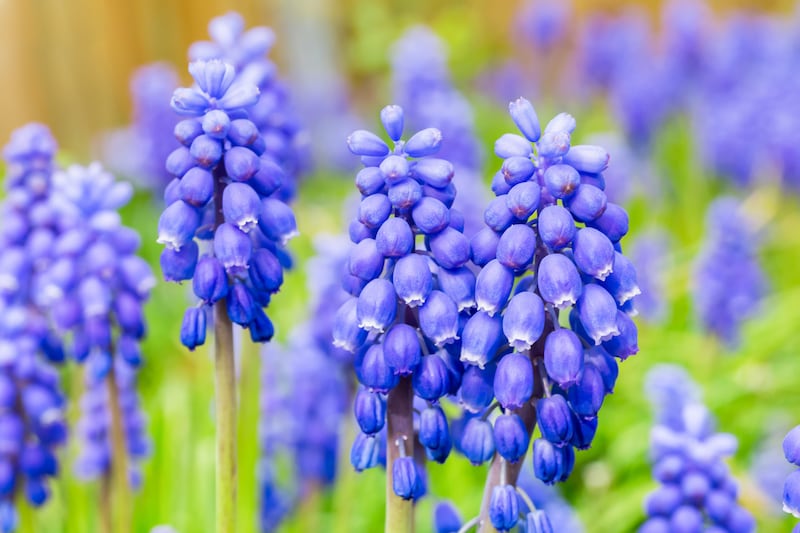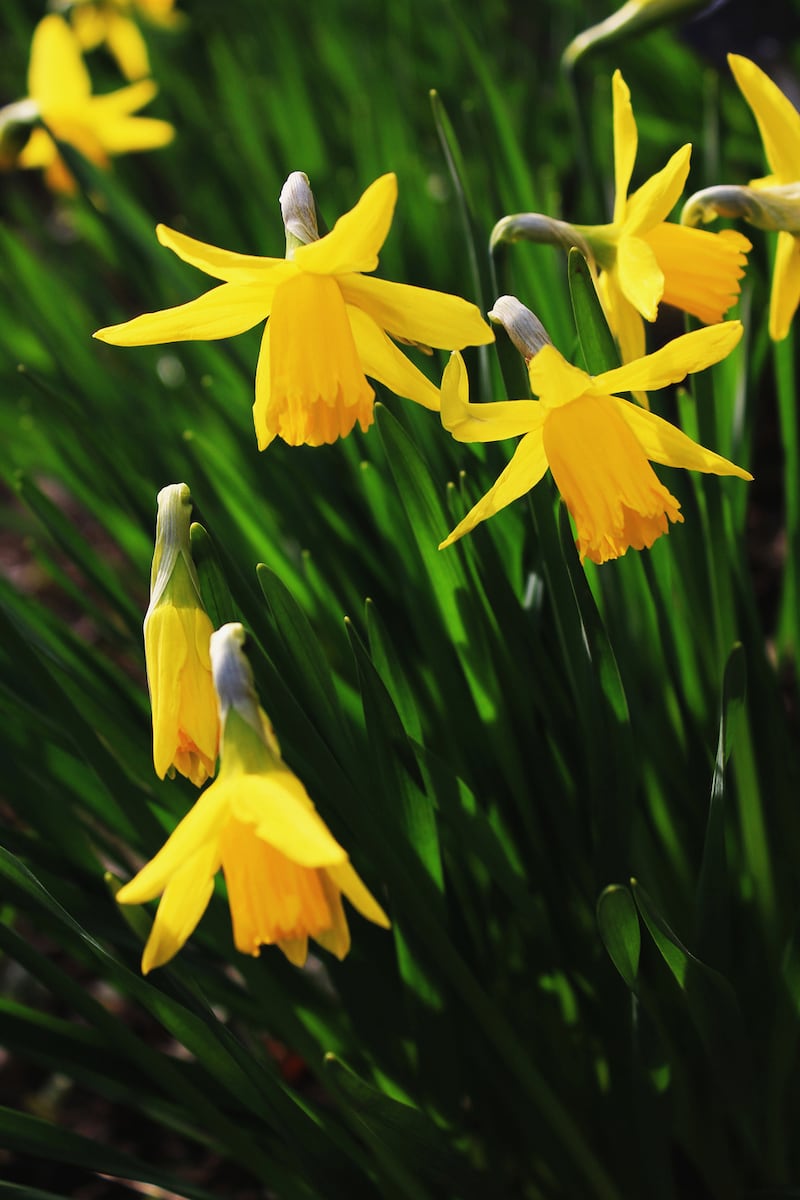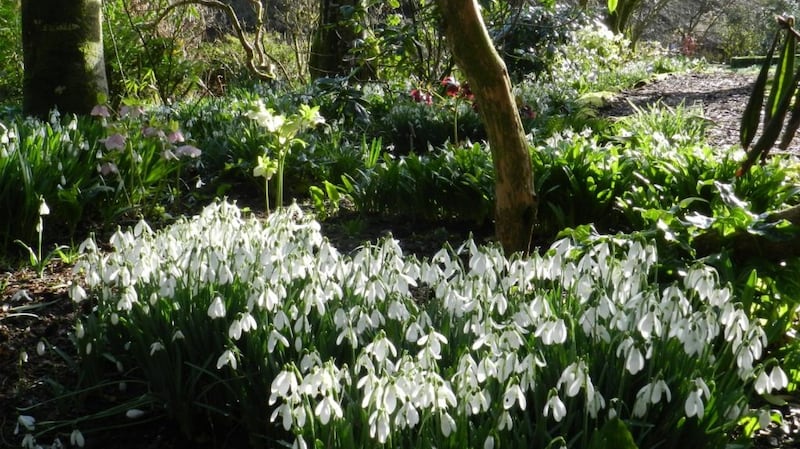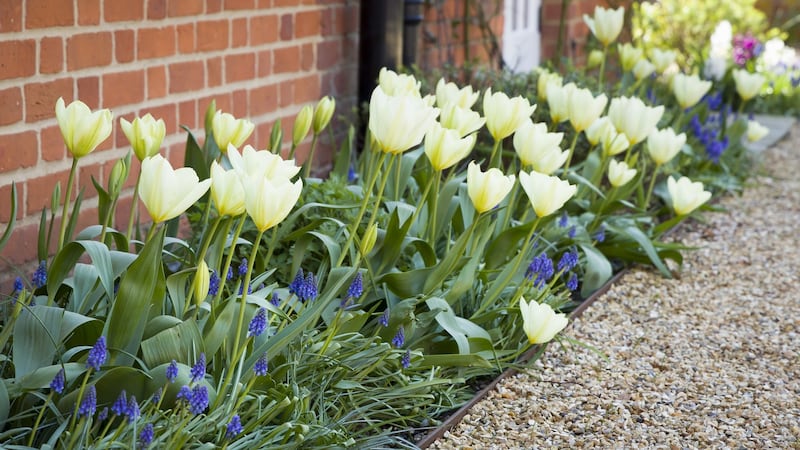Who doesn’t love a display of spring-flowering bulbs? From well-known garden favourites such as daffodils, tulips and crocuses to rarer treasures such as irises, ipheions and scillas, there’s something for every kind of gardener, including those of us with tiny courtyard gardens or window-box patches where every inch of space counts. With the latter particularly in mind, below is a short list of some of the kinds most suitable for growing in containers, pots and troughs, all of which can be planted this autumn.
Choosing varieties with dainty dimensions is, of course, one great way to make the best use of that precious growing space. Another is to plant a mix of two-three different varieties in tightly-packed layers — or what’s known as “lasagne-style”— with the largest and latest flowering varieties to the bottom of the container and the smaller, earlier-flowering varieties to the top, and each layer both sitting on and covered by a 5cm-7cm deep blanket of good-quality potting compost.
Just make sure to use a container with good drainage holes as otherwise, the lower layers of bulbs are at risk of rotting in cold, wet compost over winter. For the same reason, plant each layer densely but not so densely that the bulbs are touching each other (they should be 2-3cm apart) or touching the edges of the container, making sure to plant them pointy-end up and with the base of the bulb to the bottom.
Don’t worry about the lower layers having difficulty in pushing their way up past any upper layers. The growing tips of these kinds of flowering bulbs have a marvellous way of navigating obstacles to eventually emerge safely above ground. But do try to pick your mixture of varieties cleverly, selecting them so that as the flowers of one kind begin to fade, they’ll be followed by consecutive waves of colour and fresh foliage.
READ MORE
This mix could be two-three different varieties of the same genus of plants- for example, different kinds/varieties of tulips or of narcissus — chosen for the series of different flowering periods they provide. Or it could be a mix of different genera. For example, a top layer of crocus over a middle layer of narcissus/ daffodils over a bottom layer of tulips. In this way, you can create an everchanging, colourful, pollinator-friendly display that starts in late winter and continues into late spring. How space-efficient is that!
Ten great kinds of spring-flowering bulbs for window boxes, pots and containers
- Crocus : These tiny, jolly, pollinator-friendly flowers are ideal for the upper layer of a lasagne-style planting, typically blooming in February-early March to help kick off the display. Examples of suitable varieties include C. chrysanthus ‘Cream Beauty’ (cream-white flowers with bright orange stamens); C. chrysanthus ‘Snow Bunting’ (white flowers with bright orange stamens); and the white-flowered Crocus ‘Jeanne d’Arc’.
- Muscari: Grape hyacinths are great for container-growing, producing their decorative spikes of cone-shaped blue, white or purple flowers in mid-spring. Suitable varieties/species include the lovely Muscari armenaicum (deep-blue flowers in April-May); the pale blue-flowering cultivar known as Muscaria armenaicum ‘Valerie Finnis (April-May); and the elegant, white-flowered Muscari botryoides ‘Album’ (April-May).

- Hyacinths: Nothing beats hyacinths for the intense perfume of their flowers, making them ideal candidates for a sheltered spring-flowering window-box or pot placed close to a doorway where the scent can be fully appreciated. A good choice for the middle layer of a lasagne-style planted container, their stout, shortish, densely-packed flower spikes typically emerge in April-May. Suitable varieties include the award-winning Hyacinthus orientalis ‘Delft Blue’, the white flowered Hyacinthus orientalis ‘Carnegie’ and the deep-blue Hyacinths ‘Peter Stuyvesant’.

- Dwarf/ miniature/ cyclamineus kinds of narcissus (daffodils): Many of the daintier and/or more refined varieties of this vast genus of spring-flowering bulbs are ideal for container-growing. Examples include the ever-popular Narcissus ‘Tête à Tête’ (small yellow flowers in March); N. ‘Jetfire’ (small yellow and gold flowers in March); N. ‘Hawera’ (small, pale yellow flowers in April); N. ‘Jack Snipe’ (small, cream and yellow flowers in March; N. ‘Sailboat’ (graceful white and pale yellow flowers in April); N. ‘WP Milner’ (pale lemon and white flowers in March-April) and Narcissus ‘Minnow’ (small cream and yellow flowers in March-April).

- Snowdrop: Precious both for its beauty and as a harbinger of spring, this tiny late winter-early spring flowering bulbous plant is another great choice for the top layer of a lasagne-style planting in a window box or container. Thousands of varieties are available, many of them prohibitively expensive to buy in large quantities, but the double-flowered form of the common snowdrop, Galanthus nivalis ‘Flore Pleno’ (tiny, white-and-green frilled flowers in January-February) is vigorous, affordable and hard to beat.
- Anemone blanda: The small, starry, pretty flowers of this low-growing anemone, which is commonly known as the winter windflower, come in shades of blue, white and pink and typically appear in March. Along with the blue-flowered species (Anemone blanda), suitable varieties include the white-flowered A. ‘White Splendour’.
- Dwarf Irises: These early-flowering miniature irises are perfect for container-growing, which provides the opportunity to appreciate every finer detail of their painterly flowers. Another great choice for the top layer of a lasagne-style planted pot or window box, they’re best suited to milder, sheltered gardens. Outstanding varieties include Iris ‘Katherine Hodgkin’ (white flowers streaked with ice-blue and yellow in February-March); and the pale blue Iris reticulata ‘Alida’
- Squills: Properly known as Puschkinia scilloides var. libanotica (small, silver-blue starry flowers in March-April), this petite and very pretty spring bulb makes a lovely addition to a container. There’s also a lovely white-flowered form known as Puschkinia scilloides var. libanotica ‘Alba’. Quite the mouthful but very pretty.
- Fritillarias: Unless you’re planning on growing them in really large containers, some species of fritillaria- for example, the crown imperials- are just too tall for pots or window boxes. But the species known as Fritillaria meleagris, or the snakes head fritillary, makes a charming, elegant addition with its bell-shaped, chequered flowers in shades of smudgy purple and white that are held aloft on the slenderest of stems, appearing in late April-May. There’s also a white-flowered form. Fritillaria melagris ‘Alba’ but it has little of the subtle charm of the species.

- Tulips: This vast and impressively beautiful genus of spring-flowering bulbs is another hugely varied and complicated one, from some of the tiny species types, kaufmanniana, and single and double-early tulips that typically emerge in March-April to the many different kinds of mid-season and late flowering types that emerge in late April-May. Any of the larger, later flowering varieties make a great choice for the bottom layer of a mixed lasagne-style planting, providing a final flourish of glorious colour to finish the spring season with a bang. Examples include the much-sought-after Tulip ‘Belle Epoque’ (dusty apricot-pink double flowers); T.’Negrita’ (purple-blue single flowers in late April) and ‘Cairo’ (rose-pink/brown flowers in May).
*Recommended suppliers of spring-flowering bulbs include all good garden centres plus specialist online suppliers such as Dublin-based Mr Middleton (mrmiddleton.com), and UK-based Peter Nyssen (peternyssen.com, which delivers to Ireland via its Dutch warehouse)
This week in the garden
As autumn progresses and frost starts to hit the cooler, more inland and upland parts of the country, it’s time to start moving frost-tender plants such as argyranthemums, bedding fuchsias, plectranthus, brugmansia, and pelargoniums indoors under cover of a cool conservatory, glasshouse, polytunnel or bright porch. Likewise, dahlia tubers are also vulnerable to damage in cold, wet winters. Either cut back frost-hit plants to ground level and then cover them with a protective layer of straw, bracken or fallen leaves or cut them back and then dig the fleshy tubers up to store indoors in a cool, dark, frost-free shed or basement, making sure to label them first.
Unless you live in a very mild, sheltered part of the country, most summer bedding is well past its best by now and should be lifted and added to the compost heap over the coming weeks to free up planting space for spring-flowering bulbs and spring bedding. To speed up the composting process, use a sharp garden shears to chop the plants up into small pieces before adding them to the heap.
Dates for your diary
Today (Saturday September 24th), 11am-4pm, Ashford Heritage Centre and parish grounds, Ashford, County Wicklow, after a two-year pandemic-induced break, the Ashford Honey Festival returns today with a wide range of bee-related exhibits from observation hives and bee-friendly plants to an education marquee, see wicklowbees.com
Continuing until tomorrow, Sunday, September 25th, Mount Venus Nursery, Mutton Lane, Dublin 13, the nursery’s annual Autumn Plant Sale, see mountvenusnursery.com
Friday September 30th 2022, Killarney House, Co Kerry, ‘Creators, Improvers & Custodians of the Kingdom’s Picturesque’, a free one-day seminar exploring the designed landscapes and demesnes of Kerry including their history and their conservation, all as part of Kerry Architecture Festival 2022, with guest speakers Catherine FitzGerald, Cormac Foley, John Hegarty, Dr John Knightly, Robert O’Byrne, Dr Finola O’Kane and Elizabeth Morgan, admission free but pre-booking essential, see igs.ie
















